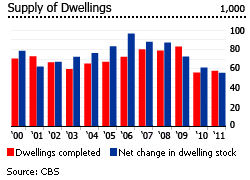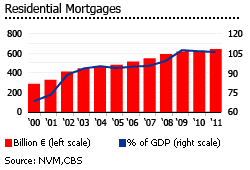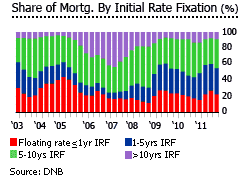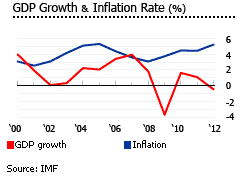No end in sight for the Dutch housing slump
 After four years of housing market slump, house prices in the Netherlands continue to fall, amid a worsening economy.
After four years of housing market slump, house prices in the Netherlands continue to fall, amid a worsening economy.
The prices of existing homes sold in Netherlands fell by 6.76% during the year to end-November 2012, according to Statistics Netherlands (CBS). When adjusted for inflation, house prices in the country actually dropped by 9.14% over the same period.
During the year to November 2012:
- The price index of single-family dwellings fell by 6.6%.
- The price index of apartments plunged by 7.5%.
Almost all cities and municipalities in the country have seen their house prices falling in November 2012. Among the major cities, Amsterdam (-11.17%) and Apeldoorn (-9.66%) have seen the biggest house price falls, according to the CBS.
ANNUAL HOUSE PRICE CHANGE (%) |
|||
| Netherlands | |||
| Amsterdam | |||
| Apeldoorn | |||
| The Hague | |||
| Groningen | |||
| Maastricht | |||
| Rotterdam | |||
| Zaanstad | |||
| Source: Statistics Netherlands (CBS) | |||
Dutch Association of Real Estate Agents (NVM) data suggests that the average house price in the Netherlands dropped by 9.21% (-11.43% in real terms) to €209,100 during the year ending in Q3 2012.
After a housing boom lasting almost 15 years, the Dutch housing market started to become weak in 2008, mainly due to the global financial meltdown.
- In 2008, house prices fell by 5.3% (-7.5% in real terms)
- In 2009, house prices dropped by 1.5% (-2.4% in real terms)
- In 2010, house prices rose slightly by 1% (-0.7% in real terms)
- In 2011, house prices dropped by 3.8% (-6.2% in real terms)
From January to November 2012, the total number of dwellings sold dropped by 7.2% to 99,897 units from the same period last year, according to CBS. From 2009 to 2011, average number of dwellings sold was less than 125,000 per year, down from an annual average of 200,300 from 2005 to 2008.
Dutch house prices are projected to continue falling in 2013, according to local property experts.
The Dutch economy entered recession in Q4 2011, when real GDP shrank by 0.6% both on a yearly and quarterly basis. The economy is expected to shrink by 1% in 2012 and by another 0.5% in 2013, based on estimates made by the Central Plan Bureau (CPB).
Housing boom and bust
The Netherlands’ house price boom lasted from 1992 to 2007, pushed by rapid economic growth. Median house prices in the Netherlands rose by about 80% (59% in real terms) from Q1 1996 to Q2 2001. Amsterdam, the capital, experienced house price growth of 111% (86% in real terms) during this period.
At the peak of the boom, national prices rose by an average of 11% (8.4% in real terms) annually from 1996-2001. During this period the economy grew 3.7% annually, and real private sector wages rose by 3.6% annually, while inflation was only 2.7%, leading to significant increases in purchasing power.
From Q3 2001 to Q1 2003, median house price growth slowed, while prices in Amsterdam and The Hague dropped. This reflected a slowdown of the Netherlands’ annual GDP growth to an average of 0.8% p.a. from 2001 to 2003. Political instability also contributed to the recession. In 2002, two governments fell (the Wim Kok government in April 2002, and the first Balkenende government in October 2002). Then the leader of the right-wing populist party (LPF), Pim Fortuyn, was killed days before the May 2002 parliamentary election.
CHANGES IN AVERAGE HOUSE PRICES (%) |
|||||
(Q1 96 – Q2 01) |
(Q3 01 – Q1 03) |
(Q2 03 – Q2 06) |
(Q3 06 – Q4 07) |
(Q1 08 – Q4 11) |
|
| Netherlands | |||||
| Amsterdam | |||||
| The Hague | |||||
| Rotterdam | |||||
| Utrecht | |||||
| Source: NVM, CBS | |||||
However the Netherlands’ political and economic situation stabilized in 2003. The economy grew by an average of 2.6% annually from 2004 to 2006, and by Q2 2006, house prices in Netherlands had risen 14% (9% in real terms) on three years earlier, with strong increases in The Hague (17.5% nominal and 12.5% in real terms) and in Utrecht (15% nominal and 10% real).
Despite political crisis during the period, house prices in the Netherlands still rose by 3% from Q3 2006 to Q4 2007, propelled by economic growth of 3.45% in 2006 and 2007. Amsterdam registered the highest house price increase of 12.6%, followed by Utrecht’s 9.9% house price increase.
House prices fell by 5.3% (-7.5% in real terms) in 2008, and by 1.5% (-2.4% in real terms) in 2009, as GDP growth slowed to 1.8% in 2008, and contracted by 3.5% in 2009. Despite modest economic recovery since then (GDP growth of 1.6% in 2010, and 1.3% in 2011) the Dutch housing market has remained depressed – a situation which is expected to continue.
Building permits at lowest since 1953

Building permits issued were down by 9% in 2011, to 55,804 - the lowest level since 1953, according to the CBS.
In 2011, the country’s total dwelling stock was up 1% from the previous year to around 7,217,803 dwellings. The total number of newly completed dwellings was up 3% in 2011 to 57,703 units, but actually down by 30.4% from 2009.
Of this total, about 6% or 417,000 units were vacant. Vacant dwellings are usually in tourist areas (e.g. West Frisian Islands), and in larger towns. Owner-occupancy is currently nearly 60% of the occupied stock, up from 42% in 1980.
Transactions have slumped
The total number of dwellings sold, at 120,739 units in 2011, is dramatically down on the average 206,000 dwellings sold annually from 2005 to 2007.
The number of dwellings sold fell to 182,392 units in 2008, to 127,532 units in 2009, and to 126,127 units in 2010.
Worse may lie ahead. In the first quarter of 2012 dwellings sold fell by 15.5% compared with Q1 last year, to about 23,951, according to CBS.
Interest rates have not fallen enough

The Netherlands’ house-price boom was encouraged by a reduction in mortgage interest rates from an average of 9.58% between 1990 and 1992, to 4.7% in May 1999. Rates then hovered between 5% to 7% from 2000 to 2002, dropping to 4.5% in 2003, 4.18% in 2004, and 3.16% in 2005, moving gradually up, as the ECB tightened, to mortgage rates of 5.34% in 2008.
When the global financial crisis exploded in Q3 2008. the ECB slashed the key 12-month Euribor rate from 4.81% in 2008 to 1.35% in 2010. However mortgage interest rates did not fully respond, falling only to 4.86% in 2009, and 4.52% in 2010. Now average mortgage interest rates are around 4.55%, despite a rise in the 12-month Euribor rate to an average of 1.94%
Irresponsible policies, over-mortgaged nation
Since the 1980s, the government has aggressively promoted homeownership, offering generous mortgage subsidies. The Dutch fiscal regime allows full tax deductibility of most mortgage interest payments at the marginal tax rate. The following requirements should be met for mortgage interest to be deducted from tax:
- The house purchased is the main residence
- The mortgage loan has a period of a maximum of 30 years
- The profit made on the sale of the previous houses is used to reduce the size of the mortgage on the next one

Mortgage market liberalization has also brought new competition. Since 1995, 90% of new mortgages have been not repayable till loan maturity, while 30% do not have to be repaid at all (“interest-only”).
As a result, the Dutch mortgage market has expanded rapidly over the past decade. Residential mortgage debt rose to almost 100% of GDP in 2008, up from 60% of GDP in 1998. In 2011, total residential mortgages were about 106% of GDP, based on data released by De Nederlandsche Bank (DNB).
To discourage excessive mortgage growth, the government implemented the following policies:
- In 2001 tax deductibility for mortgages used for non-housing consumption or investments and second-home purchases was removed.
- In 2002, interest deductibility was limited to 30 years.
- From January 2004, homeowners moving to more expensive homes have had to use their capital gains on their former house for down payment.
Nevertheless, mortgage growth continued in 2011, with total outstanding residential mortgages rising by 2.1%, to €639.6 billion.
According to a recent IMF report, the generous Dutch mortgage tax relief, which allows homeowners to deduct the full cost of their mortgages from tax, is distorting the housing market. It also means that Dutch banks are faced with higher risks because the large amount of tax relief encourages people to spend more on a house than they can actually afford.
Mortgage approvals falling

In 2011, the total amount of new mortgages approved rose by 15.5% to €73.3 billion from a year earlier.
However, in the last quarter of 2011, there were signs that the mortgage market is cooling. The total amount of new mortgage approvals in Q4 2011 was only €15.7 billion, down by 19.2% from the same quarter last year. This is a far cry from the €20 billion approved in Q2 2008, or the €30.9 billion approved in Q4 2005.
Most Dutch housing loans are fixed rate mortgages (FRM) for 5 years or more. However the shares of fixed and floating mortgages vary, depending on interest rates. When interest rates rapidly rose in 2007, households shifted to fixed rate mortgages. In Q2 2007, 43% of new loans had 10 year interest rate fixations (IRFs), while the share of loans with IRFs of less than 5 years dropped to 25%.

Social housing and the rental market
Traditionally, Holland has had a large social rental housing sector. In the 1950s, owner occupants accounted for only 29% of the housing stock.
More recently the government has been promoting home ownership, with remarkable results. Owner-occupancy rose to 42% by 1980, then to 55% by 2005. Now about 60% of the total housing stock is owner-occupied. But in many major cities (Amsterdam, The Hague, Rotterdam, and Utrecht), about 50% of the housing stock is social housing.
Homeowners receive favorable tax treatment. Aside from full income tax deductibility of mortgage interest payments; capital gains from rising house prices are also not taxed. However, this is partly offset by an annual imputed rental income tax, based on the property’s assessed value.
The government provides home-ownership grants to low-income households. Many renters also receive direct government subsidies to keep their rent-to-income ratio within certain limits.
In 2001, total government subsidies for the owner-occupied sector amounted to around €8 billion, with a similar amount provided for the rental sector. The system is highly inefficient in terms of social objectives. It also reduces mobility both for owner-occupiers and renters.
Of the total increase in dwelling stock of 65,339 units in 2011, about 40.6% are rented houses. A huge proportion of rented accommodation is owned and managed by housing corporations. They manage about 2.4 million dwellings.
Free market yields are good

Rent increases in rent-controlled dwellings are set to a maximum, equivalent to last year’s inflation. About 95% of the rental stock falls under this special regulatory framework (see Landlord and Tenant section). A landlord may impose rent increase once a year, but the government sets the maximum rental rate increases.
With inflation-based allowable rent increases generally lagging behind price increases, rental yields are generally low to moderate in the Netherlands. The maximum allowable rent increase from July 1, 2011 to June 30, 2012 was 1.3%, in effect capping rents at €630 per month.
In theory, only individuals with an annual income of below €34,000 are entitled to rent-controlled dwellings. However, a large number of high earners benefit from these rent-controlled properties. Because of this, a new law is being proposed which allows landlords to increase the rent of high earners by an extra 5% above the inflation level. However, it is still unclear when this new law will take effect.
In the small up-market decontrolled sector, which consists of around 5% of all rental dwellings. gross rental yields can be good. Non-controlled rents rose by 4.2% in 2011. Rental yields on non-controlled apartments in Amsterdam varied from around 4.4% on 250 sq. m. apartments in 2011, to around 6% on 70 sq. m. apartments, according to the Global Property Guide.
In The Hague, rental yields were somewhat higher, at around 6% on 200 sq. m. apartments, to nearly 7% on 85 sq. m. apartments.
Depressed economy

The Dutch economy entered recession in Q4 2011, when real GDP shrank by 0.6% both on a yearly and quarterly basis. The economy is expected to shrink by 1% in 2012 and by another 0.5% in 2013, based on estimates made by the Central Plan Bureau (CPB).
The country experienced uninterrupted growth for 26 years from 1982 until 2008, with an unprecedented boom in the latter half of the 1990s. There was low inflation, strong exports and virtually no unemployment. The economy grew by an average of 2.8% annually from 2004 to 2007. But one legacy of the boom years was huge mortgage debt, which now stands at well over 100% of GDP, among the highest in the eurozone.
The debt burden means the outlook for the country’s banking system is negative, according to Moody’s Investors Service. “The structural weaknesses of banks in the country include household debt, high balance-sheet leverage and considerable reliance on market funding,” says Moodys.
Unemployment is now rising. From an average of 3.46% from 2007 to 2009, the country’s unemployment rose to 4.46% in 2010 and 4.5% in 2011. In November 2012, the unemployment rate rose to 7%, according to Statistics Netherlands (CBS).
During the recession, the government was forced to boost the economy through stimulus programs and bank bailouts, which resulted in a budget deficit of 4.6% of GDP in 2009, 5.1% of GDP in 2010 and 4.8% in 2011. As a result, the country’s debt rose to 65.2% of GDP in 2011.
The Netherlands’ budget deficit was estimated at 3.8% of GDP in 2012, according to the CPB. In 2013, the budget deficit is expected to be 3.5% of GDP, above its initial forecast of 2.7%, according to the Dutch National Bank.